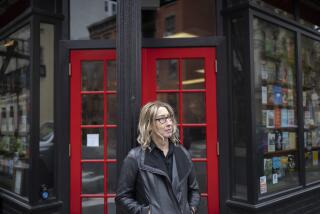Preservationist Works to Help Books in a Bind
When faulty plumbing caused flooding in the basement of UCLA’s University Research Library last spring, Christopher Coleman donned plastic gloves and began the painstaking task of salvaging the scores of books that suffered water damage.
One by one, he placed the books in front of a large fan for drying. He took other books, those that could not be dried immediately, home with him to keep in his freezer to prevent mildew.
But Coleman, a soft-spoken, meticulous bibliophile from England who was recently appointed UCLA’s head of library preservation, is responsible for more than emergency repairs.
Most of the time Coleman is looking for ways to save potentially millions of university books that are slowly turning to dust as a result of decay, mildew and insect infestation, including termites.
It is a monumental task involving up to 3.5 million books that--like most materials published after the mid-19th Century--are printed on highly acidic paper that self-destructs over time. The books threatened by acid decay represent 70% of UCLA’s collection of 5.5 million volumes.
“It’s painstaking, it can be tedious,” Coleman said. “One is frequently working against time.”
A recent survey of UCLA’s libraries showed that 8% of the university’s books were brittle, Coleman said.
Coleman is preparing a proposal to start a comprehensive book preservation effort combining the resources of UCLA’s 19 libraries. He is finishing work on a preliminary version of the proposal that will be presented to UCLA Librarian Russell Shank in December, and plans to have a more detailed report completed by next June.
Although the mildew problem is less pervasive than acid decay, Coleman said, his preservation program will stress quick salvage efforts to dry books after floods or fires, when the water used to extinguish flames also threatens books.
Cost Unknown
Coleman said the program will probably include plans to educate library employees about book care and will call for a campus emergency plan to save books in case of disaster. He said he also intends to analyze air in the libraries for pollutants that damage books, and plans to set up a laboratory to study ways to prevent book decay.
He said it is too early to say how much the program will cost.
UCLA’s book conservation program will be part of an overall effort by the University of California to preserve its collection of nearly 20 million volumes at its nine campuses. The effort, which began last year with a series of book preservation seminars sponsored by the National Endowment for the Humanities, calls for preservation librarians to be employed at each campus to prepare detailed plans for saving books.
According to a 1985 survey of UC libraries, 16.4% of the system’s books--more than 3 million volumes--were either close to disintegrating or were so brittle they could not be rebound. Another 16% were found to be in worse condition than the poorest quality newsprint.
The report concluded that more than one third of the system’s books were endangered, an amount representing about $650 million of the university’s $2-billion collection. The report also stated that $5 million to $6 million in books are permanently lost each year.
Survey’s Conclusion
“Unless prompt action is taken,” the survey concluded, “a major part of the scientific, cultural and historical record of our civilization will be lost. As a society we are rapidly losing our collective memory.”
The biggest problem facing the UC system is book decay caused by acids that either occur naturally in wood pulp or that were introduced into the paper to keep ink from “feathering,” or spreading. That process, called “sizing,” binds cellulose in the paper with alum and rosin, which over time break up the chains of molecules that keep the paper together.
In addition to agents introduced in the sizing process, other acids derive from a substance in the pulp called lignin, which gives wood its characteristic hardness.
Coleman said most books published before the mid-19th Century were printed on handmade “rag” paper made of durable, non-acidic fiber plants. Also, printers in mountain towns often bleached paper in stream water that was rich in calcium, which neutralizes acids and produces stronger paper. Consequently, many books printed before the Industrial Age remain in excellent condition, whereas some books printed only 50 years ago are falling apart.
“The old papers did very well because they had the natural calcium built into them,” Coleman said. “That’s why the early book papers are so strong and show no signs of this browning.”
A German science journal printed in 1923, for example, had turned brown and was so brittle that the corner of a page could be severed at the crease after folding. The journal must be kept in a special box to buy time as Coleman tries to find a way to prevent it from turning into dust.
Caesar’s ‘Commentaries’
By contrast, a 15th-Century edition of Julius Caesar’s “Commentaries on the Gallic Wars,” kept in the University Research Library’s department of special collections, has not significantly deteriorated in five centuries.
Books that are so brittle they can no longer be used are often microfilmed, a process that costs about $120 for a 350-page book, Coleman said.
But acid decay is only one of several problems facing books. Each year, scores of volumes at UCLA are damaged by insect infestation and mildew.
Experts rely on a variety of methods for drying books after disasters or emergencies. The simplest, but also the slowest, is to open wet books and place them before large fans. This method is most effective with small numbers of damaged books but takes too much time to prevent mildew when large numbers are involved, Coleman said.
A quicker method is to freeze books immediately after they become wet. This technique gives salvage workers time to defrost and dry books one by one rather than attempting to dry them all at once. The method is being used to restore the 700,000 books damaged by the water that was used to put out two fires at Los Angeles Central Library last year.
“When I think back to a flood we had in England,” Coleman said, “the technology had not been developed then and a lot of material had to be discarded. That was the usual way of doing things. Now it’s really quite tremendous what you can do with freezing.”
Coleman was chief bibliographer for a public library system in the Haringey district north of London before moving to Los Angeles in 1984 to obtain a master’s degree in library science from UCLA.
Although details of his preservation effort have yet to be hammered out, it is certain that the process will be time-consuming and painstaking as Coleman and his colleagues for the first time in the university’s history undertake a systematic search for the books most in danger of decay.
“We have to be vigilant in libraries because hundreds of thousands of items can be damaged in a short time,” Coleman said. “We have to be prepared to deal with these things as soon as they happen.”
More to Read
Sign up for our Book Club newsletter
Get the latest news, events and more from the Los Angeles Times Book Club, and help us get L.A. reading and talking.
You may occasionally receive promotional content from the Los Angeles Times.








